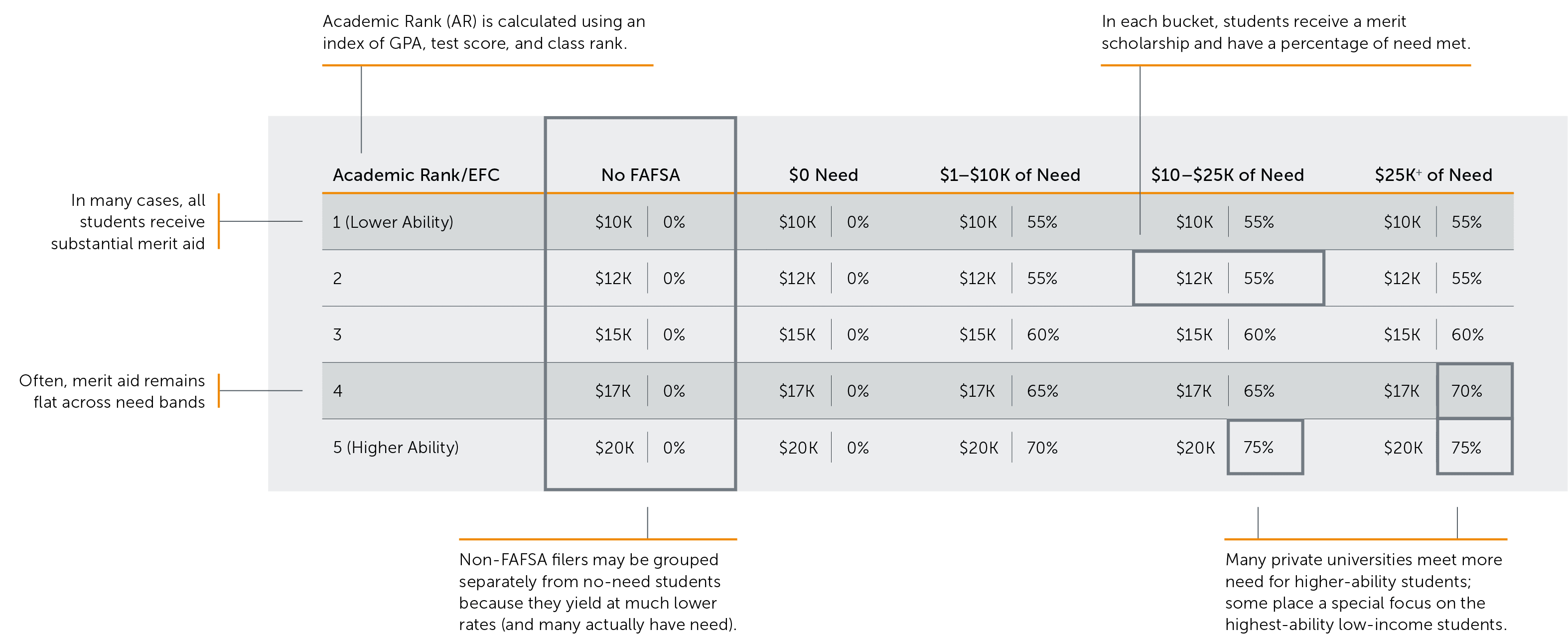How to create a financial aid policy for your college enrollment goals
Public and private colleges alike are working to allocate aid as effectively as possible to help meet enrollment goals. In our Financial Aid Optimization work, we often see public colleges focusing on limiting the expense of aid or minimizing tuition increases, while private colleges often want to minimize discount rate or possibly reset tuition.
But as the enrollment market becomes more competitive, colleges will have to embrace new financial aid strategies and ensure aid allocation achieves their institution’s specific goals, including headcount, diversity, academic profile, etc. This requires a close and critical look at your school’s financial aid policy.
I’ve outlined key steps from our financial aid optimization team’s playbook, which can guide you on how to create the right aid policy to meet your specific enrollment goals.
The dos and don’ts of financial aid policy decision-making
Most often, the vice president of enrollment is responsible for overseeing the financial aid office. However, that’s not always the case. In some instances, the chief financial officer sets a revenue goal to be achieved through class size and institutional aid expenditure. In others, a president and/or board seek to grow to expand brand visibility or reputation.
Regardless of who manages the financial aid office, our Financial Aid Optimization team has created a few ground rules for colleges to consider before going down the path of redesigning their aid policy.
Dos:
- Think of financial aid strategy as a tool to be employed to hit enrollment goals.
- Begin the conversation by agreeing on enrollment goals. Without agreement on goals, additional conversation won’t be productive. Clearly articulate these goals to the enrollment team for execution.
- Assess how well the aid policy is designed to meet enrollment goals (this will require input from the enrollment manager or someone close to the data).
- Ensure the enrollment team feels it has the resources to meet the thresholds for strategic use of aid.
Don’ts:
- Don’t think of aid (or discount rate) as an expense to minimize.
- Don’t focus on philosophical questions in the context of aid strategy discussions. Philosophical questions should be addressed in the enrollment goal-setting stage.
- Don’t make assumptions about the effectiveness of aid strategy. Use data supplied by your enrollment team to make an empirical judgment.
- Don’t assume the enrollment team is appropriately resourced to execute strategic deployment of institutional aid.
Once all parties involved in aid policy decision-making understand the dos and don’ts, it’s time to map out your aid policy.
Draft a “matrix” to determine the direction of your aid policy
“The matrix” is commonly known among those in financial aid, and creating one is critical to understanding how a college’s financial aid policy will ultimately work to achieve the school’s enrollment goals. The matrix is the visual framework of a college’s aid policy. Essentially, it’s a map.
Think about it this way: a map doesn’t only show us how to get from point A to point B. It also shows us all the various routes we can take to reach our destination. If we turn right two streets sooner, or decide to take backroads instead of the highway, what other adjustments will we need to make? An aid policy isn’t much different. Your starting point is your aid policy and your end point is meeting your enrollment goals. However, the route might need to change as your admitted-student pool develops across the enrollment cycle. So, you need your aid policy matrix to guide you.
The image below is an illustrative example, but it shows the various components of an aid policy matrix: academic rank, aid amount, and percentage of need met.

Aligning your goals to your matrix can be done in a couple of different ways. One way is to adjust the academic rank to factor in additional characteristics. The other method is to create altogether different matrices with bigger or smaller awards for different student populations, although this method lends itself best to the high-demand individual colleges or programs of a large university.
Aid allocation should be guided by your aid policy and reaffirmed by a statistical model
Before you begin allocating aid, make sure you have a statistical model in place that will allow you to see the impact of those allocation decisions. There are four main aspects of any good aid model and policy development work:
- Expected yield rates by type of award: merit, scholarship, and nee
- Scholarship yield rates in your market compared to recent years
- The historical impact of key metrics in terms of predicting enrollment
- Assumptions about the size, profile, and need levels for the admitted-student pool during the upcoming cycle
Preparing to distribute aid awards
Late summer is a critical time for aid policy development. And now that early FAFSA is prompting colleges to distribute aid awards sooner, enrollment leaders in competitive markets should make sure financial aid officers have everything they need as early into the fall semester as possible. Beyond policy development, for help with how to craft compelling aid awards, download our toolkit on the Anatomy of an Effective Aid Letter.
More Blogs

Is your yield rate okay?

Demographics shape the enrollment landscape, but strategy determines success
